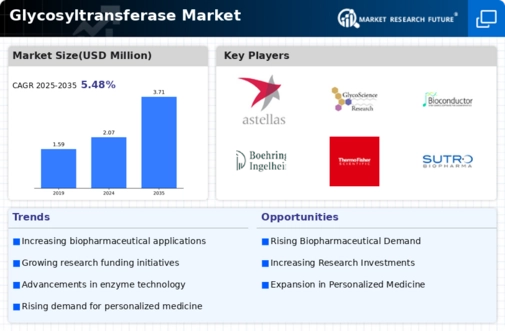Market Trends and Projections
The Global Glycosyltransferase Market Industry is characterized by notable trends and projections that indicate a robust growth trajectory. The market is expected to reach a value of 2.07 USD Billion in 2024 and is projected to grow to 3.71 USD Billion by 2035, reflecting a compound annual growth rate (CAGR) of 5.46% from 2025 to 2035. These figures suggest a strong demand for glycosyltransferases across various applications, including pharmaceuticals and biotechnology. The increasing recognition of the role of glycosylation in drug development and therapeutic efficacy further underscores the market's potential for expansion.
Growing Research in Glycobiology
The expanding field of glycobiology is a significant driver of the Global Glycosyltransferase Market Industry. Research initiatives aimed at understanding the role of glycans in biological processes are gaining momentum, leading to increased funding and collaboration among academic institutions and industry players. This growth in research is likely to enhance the application of glycosyltransferases in various sectors, including diagnostics and therapeutics. As the scientific community continues to uncover the complexities of glycan interactions, the market is poised for expansion, with a notable increase in the utilization of glycosyltransferases in innovative research projects.
Rising Demand for Biopharmaceuticals
The increasing demand for biopharmaceuticals is a primary driver of the Global Glycosyltransferase Market Industry. As the biopharmaceutical sector expands, the need for glycosyltransferases, which play a crucial role in glycan synthesis and modification, becomes more pronounced. This trend is evidenced by the projected market value of 2.07 USD Billion in 2024, reflecting a growing recognition of the importance of glycosylation in drug efficacy and safety. Biopharmaceutical companies are increasingly investing in research and development to harness glycosyltransferases for therapeutic applications, thereby propelling the market forward.
Increasing Focus on Personalized Medicine
The shift towards personalized medicine is driving growth in the Global Glycosyltransferase Market Industry. Personalized medicine relies heavily on the understanding of individual glycosylation patterns, which can influence drug response and efficacy. As healthcare providers increasingly adopt personalized treatment approaches, the demand for glycosyltransferases that can modify glycan structures to tailor therapies is likely to rise. This trend suggests a robust market potential, with a compound annual growth rate (CAGR) of 5.46% anticipated from 2025 to 2035, as stakeholders seek to develop more targeted and effective therapeutic solutions.
Regulatory Support for Biologics Development
Regulatory support for the development of biologics is fostering growth in the Global Glycosyltransferase Market Industry. Governments and regulatory bodies are increasingly recognizing the importance of biologics in modern medicine, leading to streamlined approval processes and incentives for research and development. This supportive environment encourages pharmaceutical companies to invest in glycosyltransferase-related projects, thereby expanding the market. As the landscape for biologics continues to evolve, the Global Glycosyltransferase Market is likely to benefit from enhanced regulatory frameworks that promote innovation and facilitate the introduction of new glycosyltransferase-based therapies.
Technological Advancements in Glycosylation Techniques
Technological advancements in glycosylation techniques are significantly influencing the Global Glycosyltransferase Market Industry. Innovations in enzyme engineering and synthetic biology are enabling more efficient and precise glycosylation processes. These advancements not only enhance the production of glycoproteins but also improve the overall yield and quality of biopharmaceuticals. As a result, the market is expected to grow, with a projected value of 3.71 USD Billion by 2035. The integration of automated systems and high-throughput screening methods further supports this growth, allowing for rapid development and optimization of glycosyltransferase applications.





















Leave a Comment